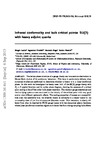Infrared conformality and bulk critical points: SU(2) with heavy adjoint quarks
| dc.contributor.author | Lucini, B | en |
| dc.contributor.author | Patella, A | en |
| dc.contributor.author | Rago, A | en |
| dc.contributor.author | Rinaldi, E | en |
| dc.date.accessioned | 2016-10-25T22:50:10Z | |
| dc.date.available | 2016-10-25T22:50:10Z | |
| dc.date.issued | 2013-09-06 | en |
| dc.identifier.uri | http://hdl.handle.net/10026.1/6629 | |
| dc.description | 28 pages, 19 figures, 14 tables. Typeset in JHEP style | en |
| dc.description.abstract |
The lattice phase structure of a gauge theory can be a serious obstruction to Monte Carlo studies of its continuum behaviour. This issue is particularly delicate when numerical studies are performed to determine whether a theory is in a (near-)conformal phase. In this work we investigate the heavy mass limit of the SU(2) gauge theory with Nf=2 adjoint fermions and its lattice phase diagram, showing the presence of a critical point ending a line of first order bulk phase transition. The relevant gauge observables and the low-lying spectrum are monitored in the vicinity of the critical point with very good control over different systematic effects. The scaling properties of masses and susceptibilities open the possibility that the effective theory at criticality is a scalar theory in the universality class of the four-dimensional Gaussian model. This behaviour is clearly different from what is observed for SU(2) gauge theory with two dynamical adjoint fermions, whose (near-)conformal numerical signature is hence free from strong-coupling bulk effects. | en |
| dc.format.extent | 106 - ? | en |
| dc.language.iso | en | en |
| dc.subject | hep-lat | en |
| dc.subject | hep-lat | en |
| dc.title | Infrared conformality and bulk critical points: SU(2) with heavy adjoint quarks | en |
| dc.type | Journal Article | |
| plymouth.author-url | http://arxiv.org/abs/1309.1614v1 | en |
| plymouth.volume | 1311 | en |
| plymouth.publisher-url | http://dx.doi.org/10.1007/JHEP11(2013)106 | en |
| plymouth.journal | JHEP | en |
| plymouth.organisational-group | /Plymouth | |
| plymouth.organisational-group | /Plymouth/Faculty of Science and Engineering | |
| plymouth.organisational-group | /Plymouth/Faculty of Science and Engineering/School of Engineering, Computing and Mathematics | |
| plymouth.organisational-group | /Plymouth/Users by role | |
| plymouth.organisational-group | /Plymouth/Users by role/Academics | |
| plymouth.organisational-group | /Plymouth/Users by role/Researchers in ResearchFish submission | |
| dc.rights.embargoperiod | Not known | en |
| rioxxterms.licenseref.uri | http://www.rioxx.net/licenses/all-rights-reserved | en |
| rioxxterms.type | Journal Article/Review | en |


